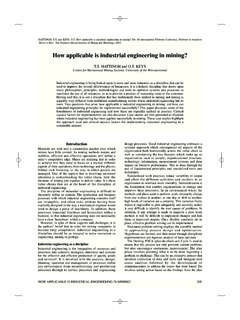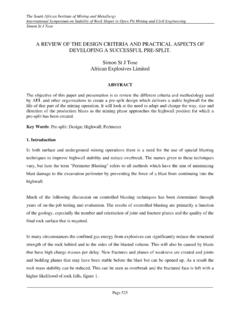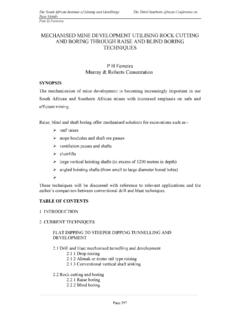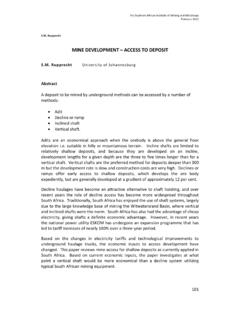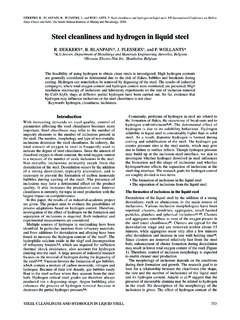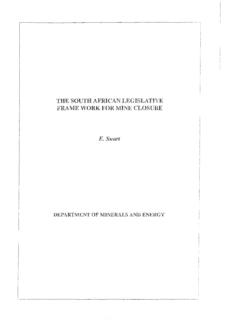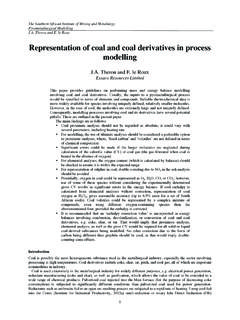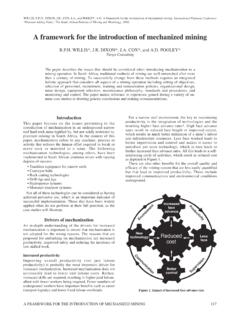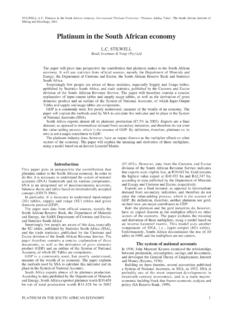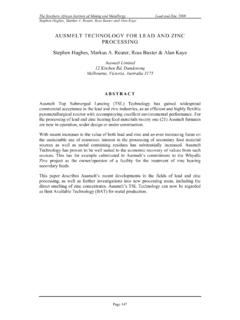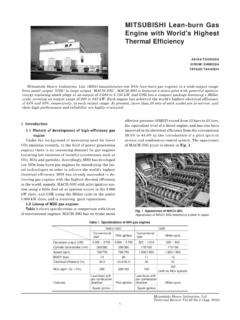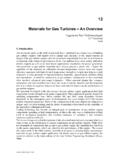Transcription of FUEL CELL TECHNOLOGY IN UNDERGROUND MINING
1 The Southern African Institute of MINING and Metallurgy Platinum 2012 533 Miller, G. van den Berg, Barnes, Eisele, Tanner, Vallely, Lassiter FUEL CELL TECHNOLOGY IN UNDERGROUND MINING Miller Vehicle Projects Inc G. van den Berg Anglo American Platinum Ltd Barnes Vehicle Projects Inc Eisele Vehicle Projects Inc Tanner Vehicle Projects Inc Vallely Vehicle Projects Inc Lassiter Vehicle Projects Inc Abstract A fuel cell locomotive incorporates the advantages of its competitors, namely catenary-electric and diesel-electric units, while avoiding their disadvantages.
2 It possesses the environmental benefits, at the vehicle, of an electric locomotive but the higher overall energy efficiency and lower infrastructure costs of a diesel locomotive. The natural fuel for a fuel cell is hydrogen, which can be produced from many renewable sources or via nuclear energy, and thus a hydrogen-fuel cell locomotive will not depend on imported oil. Hydrogen produced from renewable primary energies or nuclear energy would provide a totally zero-emissions vehicle, that is, with zero carbon in the energy cycle.
3 A project partnership among Vehicle Projects Inc of the USA, and South African partners Anglo American Platinum, Ltd, Trident South Africa, and Battery Electric, has designed and is launching a series of five prototype fuel cell-powered mine locomotives. Introduction Traction power for UNDERGROUND MINING is a challenge. Conventional power technologies tethered (including trolley), diesel, and battery are not simultaneously clean, hazard-free, and productive. For instance, tethered vehicles are power-dense and clean, but the tether is a hazard and interferes with mobility and productivity.
4 Diesel vehicles, nearly as power-dense, are more mobile and theoretically more productive, but their compliance with emissions regulations reduces actual productivity. Battery vehicles have zero emissions UNDERGROUND and good mobility, but suffer lower productivity because of low onboard energy storage (and consequently low power), as well as long recharging time. Moreover, battery vehicles are more hazardous than diesels; they have a relatively high life-cycle cost because of short battery life, and the costs of recycling toxic or hazardous materials at the end of life.
5 The Southern African Institute of MINING and Metallurgy Platinum 2012 534 A potential solution lies in using fuel cell power, which incorporates the advantages of the other technologies while avoiding their disadvantages. Fuel cell-powered vehicles have the mobility, power, and safety of a diesel unit, combined with the environmental cleanliness of a battery vehicle UNDERGROUND . Lower recurring costs, reduced ventilation costs (compared to diesel), and higher vehicle productivity could make the fuel cell mine vehicle cost-competitive several years before surface applications of the TECHNOLOGY .
6 Analyses of economic, hydrogen refuelling, and safety aspects of fuel cell mine vehicles have been undertaken by Righettini1, Kocsis2, and Betournay, et Besides providing a resolution of the traction power challenge, wide adoption of fuel cell vehicles in UNDERGROUND MINING and related applications will stimulate platinum demand. This paper discusses a project in which Vehicle Projects Inc, in collaboration with its technical partners, will manufacture a series of 10-t fuel cell-powered mine locomotives.
7 Anglo American Platinum, the project funder, will demonstrate the locomotives at the Khomanani platinum mine in Rustenburg, South Africa. Background Figure 1 Fuel cell-powered mine locomotive of Vehicle Projects Inc. Utilizing PEM fuel cells and reversible metal-hydride storage, this pure fuel cell vehicle was successfully demonstrated in a working UNDERGROUND gold mine in 2002 The Southern African Institute of MINING and Metallurgy Platinum 2012 535 In 2002, in collaboration with Placer Dome MINING Company, Vehicle Projects Inc.
8 Developed the world s first fuel cell locomotive for UNDERGROUND gold- MINING applications4-6. The 4 t locomotive is shown in Figure 1. Traction power and energy were provided solely by PEM (proton-exchange membrane) fuel cells and hydrogen stored as a reversible metal-hydride (see below). The vehicle s moderate duty cycle (see Figure 3), coupled with high power of the fuel cells, allowed the vehicle to be a pure fuel cell vehicle no traction battery was employed. As a factor contributing to its safety characteristics, the metal-hydride storage system operated at only 10 bar pressure.
9 Table I compares the fuel cell locomotive with a conventional four-ton battery mine locomotive. The fuel cell locomotive provided twice the power, longer operating time, and substantially faster recharging (refuelling) rate. Moreover, the locomotive garnered good worker acceptance in the UNDERGROUND workplace. The project was jointly funded by Placer Dome, the US Department of Energy (DOE), and the Government of Canada from its inception in 1999 to completion in 2002. Figure 2-Hydrogen fuel-cell hybrid switch locomotive developed by Vehicle Projects Inc.
10 The 130 t locomotive, developed in partnership with BNSF Railway, completed its successful demonstration at a rail yard in Los Angeles, California, in 2010 Table I-Comparison of battery and fuel cell mine locomotives Parameter Battery Fuel Cell Power, continuous Energy capacity Operating time Recharge time kW43 kWh 6 h (available) 8 h (minimum) 17 kW 48 kWh 8 h h The Southern African Institute of MINING and Metallurgy Platinum 2012 536 In 2010, Vehicle Projects Inc in collaboration with BNSF Railway Co.
